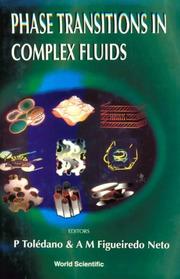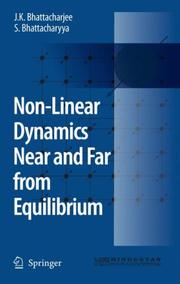| Listing 1 - 10 of 282 | << page >> |
Sort by
|
Book
Abstract | Keywords | Export | Availability | Bookmark
 Loading...
Loading...Choose an application
- Reference Manager
- EndNote
- RefWorks (Direct export to RefWorks)
This volume, of a two volume set on ionic liquids, focuses on the applications of ionic liquids in a growing range of areas. Throughout the 1990s, it seemed that most of the attention in the area of ionic liquids applications was directed toward their use as solvents for organic and transition-metal-catalyzed reactions. Certainly, this interest continues on to the present date, but the most innovative uses of ionic liquids span a much more diverse field than just synthesis. Some of the main topics of coverage include the application of RTILs in various electronic applications (batteries, capacitors, and light-emitting materials), polymers (synthesis and functionalization), nanomaterials (synthesis and stabilization), and separations. More unusual applications can be noted in the fields of biomass utilization, spectroscopy, optics, lubricants, fuels, and refrigerants. It is hoped that the diversity of this volume will serve as an inspiration for even further advances in the use of RTILs.
Amorphous substances. --- Complex fluids. --- Complex liquids --- Fluids, Complex --- Amorphous substances --- Liquids --- Soft condensed matter --- Physical Sciences --- Engineering and Technology --- Materials Science --- Fluid Dynamics --- Fluid Mechanics
Book
ISBN: 3030654702 3030654699 Year: 2021 Publisher: Cham, Switzerland : Springer,
Abstract | Keywords | Export | Availability | Bookmark
 Loading...
Loading...Choose an application
- Reference Manager
- EndNote
- RefWorks (Direct export to RefWorks)
Complex fluids. --- Fluid dynamics --- Computational fluid dynamics. --- Mathematical models. --- CFD (Computational fluid dynamics) --- Complex liquids --- Fluids, Complex --- Amorphous substances --- Liquids --- Soft condensed matter --- Computer simulation --- Data processing
Periodical
ISSN: 20937660 1226119X Year: 2011 Publisher: [Seoul] : [Australia] : Korean Society of Rheology ; Australian Society of Rheology
Abstract | Keywords | Export | Availability | Bookmark
 Loading...
Loading...Choose an application
- Reference Manager
- EndNote
- RefWorks (Direct export to RefWorks)
Physics --- Mechanics --- rheologie --- Rheology --- Complex fluids --- Deformations (Mechanics) --- Complex fluids. --- Rheology. --- Colloids --- Elasticity --- Plasticity --- Viscosity --- Complex liquids --- Fluids, Complex --- Amorphous substances --- Liquids --- Soft condensed matter --- Elastic solids --- Strains and stresses --- Structural failures --- Reologia --- Fluids complexos --- Deformacions (Mecànica)
Periodical
Abstract | Keywords | Export | Availability | Bookmark
 Loading...
Loading...Choose an application
- Reference Manager
- EndNote
- RefWorks (Direct export to RefWorks)
Chemistry --- Chemical Engineering --- Rheologie --- Zeitschrift --- deformation --- flow --- soft matter --- complex liquids --- materials --- instrumentation --- Periodikum --- Zeitschriften --- Presse --- Fortlaufendes Sammelwerk --- Fließkunde --- Strömungsmechanik --- Elastizitätstheorie --- Plastizitätstheorie --- Strömungsmechanik --- Elastizitätstheorie --- Plastizitätstheorie --- Rheologie. --- Zeitschrift.
Book
ISBN: 3030297942 3030297926 Year: 2019 Publisher: Cham : Springer International Publishing : Imprint: Springer,
Abstract | Keywords | Export | Availability | Bookmark
 Loading...
Loading...Choose an application
- Reference Manager
- EndNote
- RefWorks (Direct export to RefWorks)
This successor to the popular textbook, “Polymer Physics” (Springer, 1999), is the result of a quarter-century of teaching experience as well as critical comments from specialists in the various sub-fields, resulting in better explanations and more complete coverage of key topics. With a new chapter on polymer synthesis, the perspective has been broadened significantly to encompass all of polymer science. Polysaccharides and proteins are included in essentially all chapters, while polyelectrolytes are new to the second edition. Cheap computing power has greatly expanded the role of simulation and modeling in the past two decades, which is reflected in many of the chapters. A supplementary chapter on basic thermodynamics is based on a course that the senior author has taught for seven years. Additional problems and carefully prepared graphics aid in understanding. Two principles are key to the textbook’s appeal: 1) Students learn that, independent of the origin of the polymer, synthetic or native, the same general laws apply, and 2) students should benefit from the book without an extensive knowledge of mathematics. Taking the reader from the basics to an advanced level of understanding, the text meets the needs of a wide range of students in chemistry, physics, materials science, biotechnology, and civil engineering, and is suitable for both masters- and doctoral-level students. Praise for the previous edition: ...an excellent book, well written, authoritative, clear and concise, and copiously illustrated with appropriate line drawings, graphs and tables. - Polymer International ...an extremely useful book. It is a pleasure to recommend it to physical chemists and materials scientists, as well as physicists interested in the properties of polymeric materials. - Polymer News This valuable book is ideal for those who wish to get a brief background in polymer science as well as for those who seek a further grounding in the subject. - Colloid Polymer Science The solutions to the exercises are given in the final chapter, making it a well thought-out teaching text. - Polymer Science.
Soft and Granular Matter, Complex Fluids and Microfluidics. --- Polymer Sciences. --- Amorphous substances. --- Complex fluids. --- Polymers . --- Polymere --- Polymeride --- Polymers and polymerization --- Macromolecules --- Complex liquids --- Fluids, Complex --- Amorphous substances --- Liquids --- Soft condensed matter --- Polymers.

ISBN: 1280451297 9786610451296 1602560471 1423758633 0195357078 1601193025 9781601193025 9781423758631 9781602560475 0195097181 9780195097184 019770414X Year: 2023 Publisher: New York ; Oxford University Press,
Abstract | Keywords | Export | Availability | Bookmark
 Loading...
Loading...Choose an application
- Reference Manager
- EndNote
- RefWorks (Direct export to RefWorks)
This is a self-contained presentation of the optical methods used to measure the structure and dynamics of complex fluids subject to the influence of external fields. Such fields (hydrodynamic, electric and magnetic) are commonly encountered in academic and industrial research.
Complex fluids. --- Fluid dynamic measurements. --- Rheology. --- Colloids --- Deformations (Mechanics) --- Elasticity --- Plasticity --- Viscosity --- Fluid dynamics --- Measurements, Fluid dynamic --- Physical measurements --- Complex liquids --- Fluids, Complex --- Amorphous substances --- Liquids --- Soft condensed matter --- Measurement

ISBN: 9812816828 9789812816825 9810232608 9789810232603 Year: 1998 Publisher: Singapore ; River Edge, NJ : World Scientific,
Abstract | Keywords | Export | Availability | Bookmark
 Loading...
Loading...Choose an application
- Reference Manager
- EndNote
- RefWorks (Direct export to RefWorks)
This important and timely book deals with the theoretical and experimental investigation of the phase transitions which occur in complex fluid systems, namely lyotropic systems, microemulsions, colloids, biological membranes, and ferrofluids. It contains 17-odd review papers from the major contributors to this rapidly growing field of research, summarizing the main results obtained in the description and understanding of the phase transitions taking place between the isotropic, nematic, cholesteric, lamellar, hexagonal, and cubic mesophases of complex fluids.
Complex fluids. --- Phase transformations (Statistical physics) --- Phase changes (Statistical physics) --- Phase transitions (Statistical physics) --- Phase rule and equilibrium --- Statistical physics --- Complex liquids --- Fluids, Complex --- Amorphous substances --- Liquids --- Soft condensed matter

ISBN: 1281756563 9786611756567 1402053886 1402053878 Year: 2007 Publisher: Dordrecht, The Netherlands : Springer,
Abstract | Keywords | Export | Availability | Bookmark
 Loading...
Loading...Choose an application
- Reference Manager
- EndNote
- RefWorks (Direct export to RefWorks)
This text gives a detailed account of various techniques that are used in the study of dynamics of continuous systems, near as well as far from equilibrium. The analytic methods covered include diagrammatic perturbation theory, various forms of the renormalization group and self-consistent mode coupling. Dynamic critical phenomena near a second order phase transition, phase ordering dynamics, dynamics of surface growth and turbulence form the backbone of the book. Applications to a wide variety of systems (e.g. magnets, ordinary fluids, superfluids) are provided covering diverse transport properties (diffusion, sound). It is unique in that it gives a detailed description of perturbation theory for nonlinear continuous systems, it focuses on techniques which can be applied to problems ranging from near equilibrium dynamics to fully developed turbulence, and it provides a discussion of physical properties (e.g. critical ultrasonics) that are generally not covered in text books. Audience: Beginning graduate students, senior undergraduates, researchers.
Dynamics. --- Nonlinear systems. --- Statistical physics. --- Physics --- Mathematical statistics --- Statistical methods --- Systems, Nonlinear --- System theory --- Dynamical systems --- Kinetics --- Mathematics --- Mechanics, Analytic --- Force and energy --- Mechanics --- Statics --- Complex Systems. --- Soft and Granular Matter, Complex Fluids and Microfluidics. --- Statistical Physics and Dynamical Systems. --- Dynamical systems. --- Amorphous substances. --- Complex fluids. --- Complex liquids --- Fluids, Complex --- Amorphous substances --- Liquids --- Soft condensed matter
Book
ISBN: 3540698086 3540698078 Year: 2008 Publisher: Berlin, Heidelberg : Springer,
Abstract | Keywords | Export | Availability | Bookmark
 Loading...
Loading...Choose an application
- Reference Manager
- EndNote
- RefWorks (Direct export to RefWorks)
It is generally accepted that a new material is often developed by ?nding a new synthesis method of reaction or a new reaction catalyst. Historically, a typical example may be referred to as a Ziegler–Natta catalyst, which has allowed large-scale production of petroleum-based polyole?ns since the middle of the 20th century. New polymer synthesis, therefore, will hopefully lead to creation of new polymer materials in the 21st century. This special issue contributed by three groups focuses on recent advances in polymer synthesis methods, which handle the cutting-edge aspects of the advanced technology. The ?rst article by Yokozawa and coworkers contains an overview of the - action control in various condensation polymerizations (polycondensations). Advanced technologies enabled the control of stereochemistry (regio-, g- metrical-, and enantio-selections), chemoselectivity, chain topology, and st- chiometry of monomers, giving a high molecular weight polymer. It has been recognized for a long time, however, that polycondensation is a dif?cult p- cess in controlling the reaction pathway, because the reaction is of step-growth and the reactivity of monomers, oligomers, and polymers are almost the same during the reaction and hence, the molecular weight of polymers and its d- tribution (M /M ) are impossible to regulate. The authors’ group developed w n a new reaction system (chain-growth condensation polymerization), changing the nature of polycondensation from step-growth to chain-growth; namely the propagating chain-end is active, allowing for control of the product molecular weight as well as the distribution.
Polymerization. --- Polymerisation --- Polymers --- Polymers and polymerization --- Synthesis of polymers --- Chemical reactions --- Synthesis --- Polymers. --- Chemistry, Organic. --- Polymer Sciences. --- Soft and Granular Matter, Complex Fluids and Microfluidics. --- Organic Chemistry. --- Organic chemistry --- Chemistry --- Polymere --- Polymeride --- Macromolecules --- Polymers . --- Amorphous substances. --- Complex fluids. --- Organic chemistry. --- Complex liquids --- Fluids, Complex --- Amorphous substances --- Liquids --- Soft condensed matter
Book
ISBN: 1281862150 9786611862152 3540745556 3540745548 3642093957 Year: 2008 Publisher: Berlin ; New York : Springer,
Abstract | Keywords | Export | Availability | Bookmark
 Loading...
Loading...Choose an application
- Reference Manager
- EndNote
- RefWorks (Direct export to RefWorks)
This book deals with the formulation of the thermodynamics of chemical and other systems far from equilibrium, including connections to fluctuations. It contains applications to non-equilibrium stationary states and approaches to such states, systems with multiple stationary states, stability and equi-stability conditions, reaction diffusion systems, transport properties, and electrochemical systems. The theoretical treatment is complemented by experimental results to substantiate the formulation. Dissipation and efficiency are analyzed in autonomous and externally forced reactions, including several biochemical systems.
Chemical equilibrium. --- Thermodynamics. --- Chemistry, Physical and theoretical --- Dynamics --- Mechanics --- Physics --- Heat --- Heat-engines --- Quantum theory --- Equilibrium, Chemical --- Phase rule and equilibrium --- Chemistry, Physical organic. --- Soft and Granular Matter, Complex Fluids and Microfluidics. --- Physical Chemistry. --- Chemistry, Physical organic --- Chemistry, Organic --- Amorphous substances. --- Complex fluids. --- Physical chemistry. --- Chemistry, Theoretical --- Physical chemistry --- Theoretical chemistry --- Chemistry --- Complex liquids --- Fluids, Complex --- Amorphous substances --- Liquids --- Soft condensed matter
| Listing 1 - 10 of 282 | << page >> |
Sort by
|

 Search
Search Feedback
Feedback About UniCat
About UniCat  Help
Help News
News